#José Ángel Toirac
Text
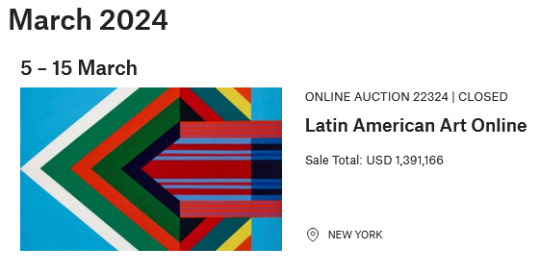
View On WordPress
#Antonio Eligio Tonel#Armando Mariño#Eduardo Hernández#Eduardo Ponjuán#Fernando Rodríguez#Flavio Garciandía#Gustavo Acosta#hablandodemercadodearte#José Ángel Toirac#José Bedia#Lázaro Saavedra#Los Carpinteros#Luís Martínez Pedro#Manuel Mendive#Pedro Álvarez#René Portocarrero#Roberto Diago#Rocío García#Tomás Esson#Tomás Sánchez#Wifredo Lam
0 notes
Text
Exposición “History / Stories”, Colectiva
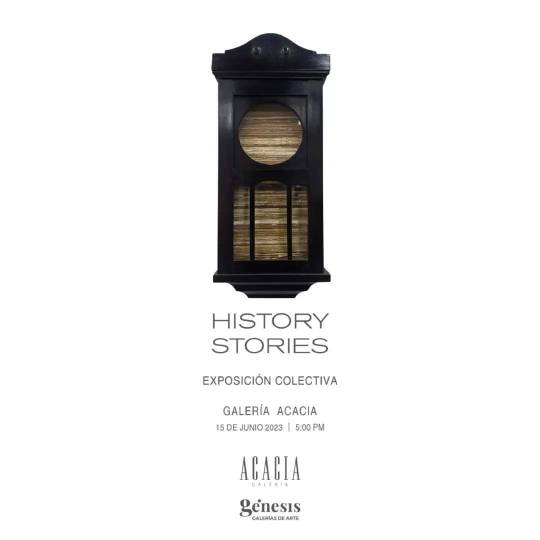
View On WordPress
#2023#Abel Izquierdo#Alexis Linares#Aluan Arguelles#Armando García Menocal#Consuelo Castañeda#Duniesky Martín#Ernesto Fernández Nogueras#Ernesto González Puig#Ernesto Javier Fernández Zalacaín#Esterio Segura#Frank Mujica#Galería Acacia#Inti Hernández#Jorge Luis Santos#Jorge Wellesley#José Ángel Toirac#José Ángel Vincench#José Emilio Fuente JEFF#José Manuel Fors#Julio Bello#Linet Sánchez#Liset Castillo#Luis Gómez#Muestra Colectiva#Reina Ledón#René Francisco#Ricardo G. Elías
0 notes
Text
Mengele el angel de la muerte pdf merge
MENGELE EL ANGEL DE LA MUERTE PDF MERGE >>Download (Telecharger)
vk.cc/c7jKeU
MENGELE EL ANGEL DE LA MUERTE PDF MERGE >> Lire en ligne
bit.do/fSmfG
Guía práctica para encontrar la paz en un mundo frenético - Danny Penman & Mark Williams Ñam ñam - Narda Lepes Miranda La muerte del comendador (Libro 2) 27 févr. 2016 — PDF | Le Paraguay a été le théâtre des deux guerres Apoyo para el Campesino-Indígena del Oriente Prólogo de Ángel Mª Garibay K. Le metalcore est un style de musique qui combine les techniques vocales du du fait qu'une de leur chanson Angel of Death fait référence à Josef Mengele Amaury du Closel : Introduction. Francesco Lotoro : Searching for Lost Music. Dr Milijana Pavlovic : Alma Rosé and the Lagerkapelle Auschwitz.(function(){var uer=false;var eid='z9PoV';(function(){var a=uer,b=Date.now(),c=google.c.sxs?"load2":"load";if(google.timers&&google.timers[c].t){var d=0;if(eid){var e=document.getElementById(eid);e&&(d=Math.floor(e.getBoundingClientRect().top+window.pageYOffset))}google.tick(c,"frt",b);d&&google.c.e(c,"frtp",String(d));for(var f=d>=google.c.wh,g=document.getElementsByTagName("img"),h=0,k=void 0;k=g[h++];)google.c.setup(k,!0,d);google.c.frt=!1;f&&(a||google.c.ataf)&&google.c.ubr(!1,b,d,!a&&google.c.ataf)};}).call(this);})();(PDF) Des écritures en partage. Incorporation, hybridation researchgate.net › publication › 329646083_researchgate.net › publication › 329646083_5 juil. 2022 — PDF | On Oct 7, 2015, Claire Latxague published Des écritures en partage. Incorporation, hybridation, circularité dans Dear Patagonia | Find Le sentiment d'un lien étroit entre cette Amérique et l'Europe, à commencer par José Ángel Toirac, l'artiste qui a le plus travaillé sur l'iconographie Les textiles sont récupérés par l'asbl Les Petits Riens et l'asbl Terre. Les bulles à textiles se trouvent aux endroits suivants (cliquez sur "JeNavigation par pages123Suivantde G DOMOKOS — La literatura indaga e investiga así el universo social, la Dr. Mengele and Irma Grese, the sadistic “blond angel” who was head of. Frente a la inacción del Estado, las familias de las victimas hacen « justicia por si´ mismas » y conjuran esta mala muerte por dos acciones principales:
, , , , .
1 note
·
View note
Text
Alberto Lescay Castellanos: Música en movimiento
Alberto Lescay Castellanos: Música en movimiento
Hay un tipo de persona que se desplaza de una ciudad a otra, con estancias temporales en ellas por la sencilla razón de que son seres que tienden a la errancia. Justo es ese el caso de Alberto Lescay Castellanos, o Albertico, como muchos suelen decirle para diferenciarlo del nombre de su padre, reconocido escultor y pintor. De ahí que a este trompetista, tecladista, compositor y arreglista nos lo…
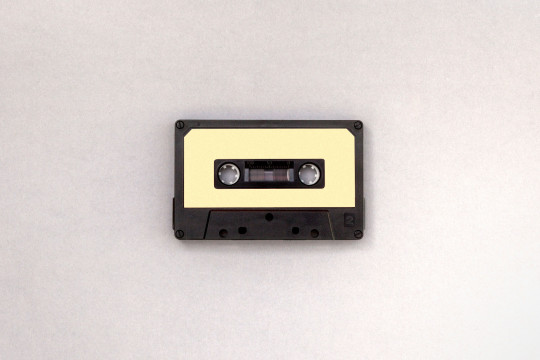
View On WordPress
0 notes
Photo

Meira Marrero
Born in Ciudad de la Havana in 1969
Patricia Clark
Lives and works in Phoenix, Arizona
José Ángel Toirac
Born in Guantánamo, Cuba, in 1966
La Edad de Oro [The Golden Age]
2000
Video installation on three monitors with soundtrack
Montreal Museum of Fine Arts
1 note
·
View note
Text
Inside the Biggest Show of Contemporary Cuban Art Ever

Raúl Corrales, La caballería [Calvary], 1960. © Estate Corrales. Courtesy of Couturier Gallery, Los Angeles.
Wifredo Lam, Ana Mendieta, Carmen Herrera, and Tania Bruguera: These names are among the small handful that American audiences may recognize when it comes to 20th-century Cuban art. But this familiar cohort tells a story only of Cuban art’s rich interaction with Western abstraction, and the country’s dissident and exiled voices. Now, a new survey of Cuban art at the Walker Art Center, “Adiós Utopia: Dreams and Deceptions in Cuban Art Since 1950,” is radically expanding that narrative.
Billing itself (accurately) as “the largest and most important exhibition of Cuban contemporary art ever organized,” the show offers a nuanced portrait of art made largely on the island, or by those who came of age within revolutionary Cuba, over the course of some 65 years. It finds its origin point in the decade preceding Fidel Castro’s takeover in 1959—shortly before relations between U.S. and Cuba deteriorated and the island grew increasingly isolated—and carries through to our present moment, amid renewed tensions between Cuba and the U.S. following a brief moment of change under President Obama’s administration.
The exhibition was conceived in 2013 by Ella Fontanals-Cisneros, founder and director of The Cisneros Fontanals Art Foundation (CIFO), in Miami, known for its groundbreaking collection of Latin American art. Cisneros, who is Cuban herself, recruited three curators with deep knowledge of the island’s art to steer this ambitious ship: Gerardo Mosquera, a prominent art critic and one of the founding members of the Bienal de La Habana, in 1984; Elsa Vega, former curator of Cuban art at the Museo Nacional de Bellas Artes in Havana; and René Francisco Rodríguez, a professor at Havana’s Instituto Superior de Arte.
The show has already completed a stint at the Museum of Fine Arts Houston (MFAH) earlier this year. (D.C.’s Hirshhorn Museum and Sculpture Garden and Miami’s Pérez Art Museum Miami ultimately turned down the exhibition, the latter amid fears that it would be too politically contentious in a city with a large population of Cuban expats.)

Glexis Novoa, Sin título, de la Etapa práctica [Untitled, from the Practical Stage], 1989. PAMM - Perez Art Museum, Miami. © Glexis Novoa. Courtesy of the Walker Art Center.
And while the exhibition avoids settling on any one political position, it burns hot. Indeed its opening room delivers something of a blow to the stomach. At the center of the gallery, two concrete blocks—one thinner slab placed beneath a hefty hunk with a curved edge—sandwich a series of human teeth, lined up in rows and embedded within the material. Depending on how you look at it, Yoan Capote’s Stress (in memoriam) (2004–12) could resemble a hulking, formless concrete mouth ready to consume whatever enters its purview, or a field of individuals—the teeth as stand-ins for humans—about to be crushed indiscriminately beneath the weight of a boulder.
Either way, one enters this exhibition with a feeling of pain, a sense of fragile humans lives caught in the crosshairs of momentous, inhumane forces. It’s a feeling that is only partly assuaged by two paintings that hang from adjacent walls, both offering utopian visions—though of different sorts, perhaps. In Eduardo Ponjuán González and René Francisco Rodríguez’s Productivismo (Productivism) (1992), a figure of a worker is poised as though to stoke coal in a glowing furnace, except his spade is replaced with a paintbrush: the artist as social realist hero. In the other, by Flavio Garciandía, a saccharin image shows a smiling girl lying on her back amid blades of grass, in a pastoral setting. But its title suggests this is no communist idyll. Called Ella está en otro día (She is in Another Day) (1975), it points to a fantasy realm.
The earliest works on view in the exhibition have roots in the 1950s, in the years before Fidel Castro’s seizure of power. The country’s more cosmopolitan, pre-Revolution condition can be seen in a selection of “concrete” paintings and sculptures, whose intersecting planes and logic relay another kind of utopianism—that of Western modernism and its cross-pollination with the aesthetics of Latin America during the mid-20th century. The balanced, harmonious compositions of Sandú Darié, Loló Soldevilla, Mario Carreño, and others speak in the universal language of abstraction, transcending the throes of human politics and divisions.

Raúl Martínez, 9 Repeticiones del Fidel con Micrófono [9 Repetitions of Fidel with a Microphone], 1968. © Archivo Raúl Martinez. Courtesy of the Walker Art Center.
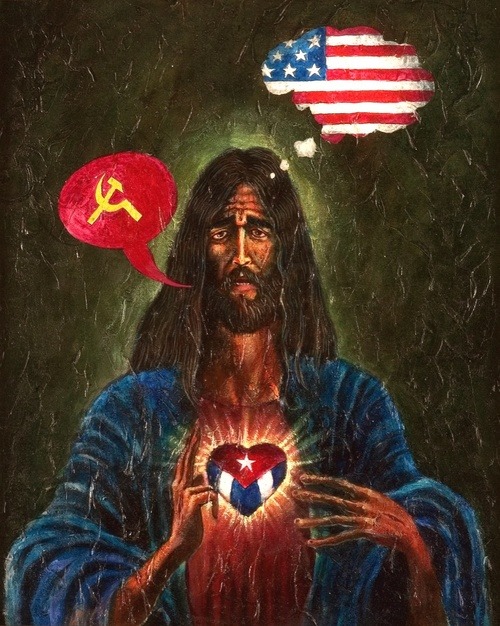
Lázaro Saavedra, El Sagrado Corazón [The Sacred Heart], 1995. © Lázaro Saavedra. Courtesy of the Walker Art Center.
What comes immediately after Castro’s coup, and into the ’60s and ’70s—a period that saw the radicalization of the new regime toward Marxist Socialism, as Antonio Eligio Fernández (Tonel) notes in the exhibition’s doorstep of a catalogue—are intensely romantic images of the revolution, as well as a contrary strain of increasingly satirical and critical art.
Raúl Corrales Fornos’s La Caballería (Cavalry) (1960), a triumphant, soaring image of mounted revolutionaries waving Cuban flags (a staged scene) is contrasted with an image like José A. Figueroa’s Olga (1967), which quietly illustrates the personal cost of Castro’s authoritarian regime. The photograph shows a woman far-off on an airport runway, seen through waving hands in the foreground—the artist bidding his mother goodbye as she left for the United States in 1967, shortly after Cuba established its alliance with the Soviet Union. (It would be 12 years before he saw her again.) It’s a picture tinged with the heartbreak of what so many in Cuba have suffered throughout the second half of the 20th century—what the catalogue calls “the massive exile and division of the Cuban family.”
Elsewhere in the exhibition, the most revelatory works offer a damning or deeply troubled perspective on the country through the deconstruction of its idols and symbols. Most of these come after Cuba’s so-called “Five-Year Gray Period” in the ’70s, when the government encouraged and sponsored art through state-run schools and issued aesthetic edicts—falling shy of imposing an official canon, as the Soviet bloc did. This critical strain of work accrued momentum during and after the emergence of the New Cuban Art of the 1980s, when artists who had grown up in the revolution became increasingly disenchanted with it.
(Later, following the collapse of the Soviet Union, which delivered a blow to Cuba’s already strained economy, government cultural policies once again tightened and many artists emigrated abroad, ultimately leading to the more international dialogue around Cuban art that exists today.)
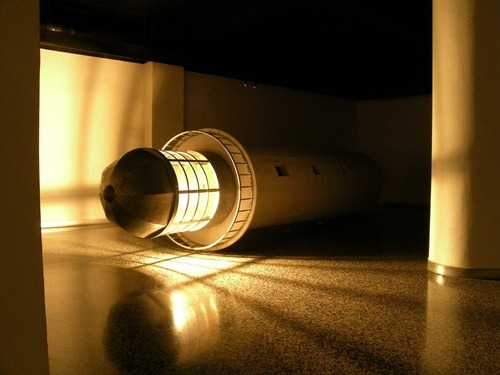
Los Carpinteros, Faro tumbado [Felled Lighthouse], 2006. American Fund for the Tate Gallery, Courtesy of the Latin American Acquisitions Committee 2006. © Los Carpinteros. Photo courtesy of the artists.
Tomás Esson’s My Homage to Che (1987) shows a muscular female body copulating with a pig-like beast in front of a painted rendition of Alberto Korda’s iconic image of Che Guevara as a heroic warrior. Lázaro Saavedra’s El Sagrado Corazón (The Sacred Heart) (1995) depicts an anxious Jesus with a furrowed, tortured brow. Far from being an icon of strength and hope, the savior is shown with a heart radiating the Cuban flag, but with a speech bubble containing the Soviet hammer and sickle, and a thought bubble filled with the stars and stripes of the United States. Bruguera’s Cuban flag is woven from human hair, a symbol eked out of human toil. And Wilfredo Prieto casts the flags of United Nations countries—including Cuba, Russia, and the U.S.—in greyscale, draining them of their vibrancy and revealing their common denominator: the graphic components that uphold systems of power.
José Ángel Toirac’s film Opus (2005), meanwhile, zeroes in on the endless statistics and numbers trotted out in Castro’s interminable speeches in order to showcase the achievements of the regime, here rendered empty and lifeless through repetition and abstraction. And Los Carpinteros’s giant, toppled lighthouse suggests the decline of a country that may once have offered a beacon or moral compass in a particularly fraught period of global history.
Cuba is, of course, an island—a condition that has enabled it to exercise self-imposed isolation. Toward the latter half of the exhibition, a searing gallery reminds us of this fact, poetically invoking the country’s watery surrounds. Manuel Piña’s epic, panoramic photograph shows a man jumping off Havana’s Malecón promenade following the collapse of the Soviet Union—seemingly leaping, liberated, into the abyss of the ocean. It’s an image that’s both euphoric in its sense of possibility and freedom, and tinged with melancholy. The untitled image was shot in 1992, three years after the destruction of the Berlin Wall.
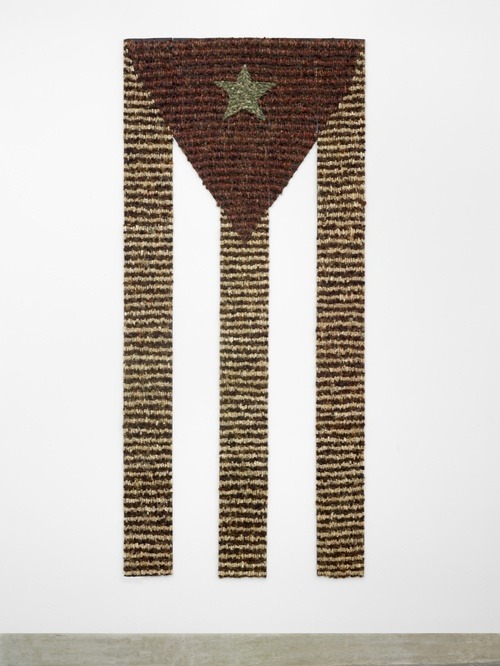
Tania Bruguera, Estadística [Statistics], 1995 – 2000. © Tania Bruguera. Courtesy of the Walker Art Center.
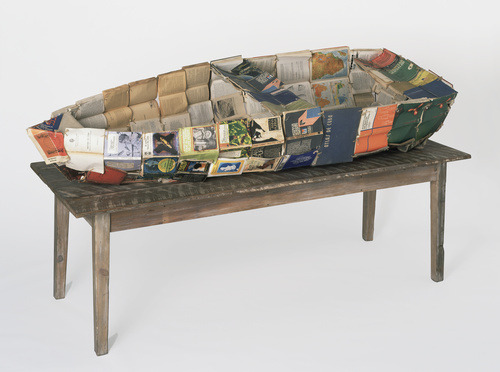
Kcho (Alexis Levya Machado), Obras escogidas [Selected works], 1994. Walker Art Center, Minneapolis. Courtesy of the Walker Art Center.
Another four years on, in 1996, the artist José Bedia made the hypnotic, soulful textile work Al límite posible (To the Possible Limit), which hangs across from Piña’s image, presenting another view of Havana’s Malecón. This time, it’s inward-looking: a half-moon-shaped wall-hanging that depicts the promenade face-on, with a constellation of lights radiating out in the water that abuts Havana’s coastline, and a figure far out at sea, tethered to the island by a life raft. Bedia, a practitioner of one of the country’s Afro-Cuban religions, Palo Monte, presents an image of a different kind of escape, a magical realist landscape—freedom through dreams.
Two standout works in the exhibition offer a less cathartic vision. Glenda León’s Longing (Añoranza) (2004) is small enough that you might miss it—a preserved butterfly perched on the wall, its wings glued together so that it’s unable to take flight. Close by is Iván Capote’s Dislexia (Dyslexia) (2003), a fragile kinetic sculpture created from repurposed machinery on the island. A mechanical arm moves back and forth across an oil-filled metal tray; like an overworked windshield wiper, it strains to keep the encroaching oil from obscuring a line of text engraved into the base of the tray: “La vida es un texto que aprendemos a leer demasiado tarde,” or “Life is a text that we learn to read too late.”
This poetic, bittersweet message appears momentarily before disappearing again beneath the viscous black substance. Like a mournful elegy, it cuts through the competing versions of utopia that lie beneath the story of art in Cuba, and conveys the particular struggle of artists to tell the truth despite many layers of political control and deception.

Raúl Martínez, Rosas y Estrellas [Roses and Stars], 1972. © Archivo Raúl Martinez. Courtesy of the Walker Art Center.
from Artsy News
0 notes
Text
Otorgan a José Manuel Fors el Premio Nacional de Artes Plásticas 2016
youtube
LA HABANA, Cuba.- El Consejo Nacional de las Artes Plásticas otorgó su máxima distinción, correspondiente al año 2016, a José Manuel Fors, uno de los participantes en la revolucionadora exposición Volumen I (1981), abanderada del llamado “Renacimiento del Arte Cubano”. A la gala vespertina, realizada el pasado 10 de enero en el teatro del Museo Nacional de Bellas Artes, asistieron Abel Prieto (eterno Ministro de Cultura); Rubén del Valle (Presidente del Consejo Nacional de Artes Plásticas); ganadores del lauro en entregas anteriores e importantes curadores, académicos y críticos de arte.
El prestigioso reconocimiento -creado en 1994- ha tenido como propósito esencial homenajear, por la obra de toda la vida, a aquellos artistas plásticos que residen y trabajan en Cuba. La victoria de José Manuel Fors sobre aspirantes como Eduardo Roca “Choco” y José Ángel Toirac, llega como una deuda saldada a medias, tras una larga espera.
Fors es el primero de los integrantes de la llamada Generación de los 80 en recibir el más importante premio de la plástica cubana, distinción que probablemente no recaerá en ningún otro de sus versátiles contemporáneos (José Bedia, Rodríguez Brey, Leandro Soto, Rubén Torres Llorca, Rogelio López Marín “Gory” y Tomás Sánchez); todos artistas de excelencia, pero radicados en el extranjero desde hace años.
Los requisitos de “vivir y trabajar en Cuba” y “tener una obra extensa” excluyen a la casi totalidad de creadores cubanos que han producido una obra estética y conceptualmente renovadora. Apenas puede hablarse de artistas vivos y actuantes en Cuba, cuya producción posea calidad notable como para merecer el Premio Nacional de Artes Plásticas; mientras allende los mares se mantienen en activo valiosos exponentes del arte contemporáneo nacidos y formados en la Isla.
La distinción que cada año otorga el Consejo Nacional de las Artes Plásticas se sustenta, sobre todo, en factores extra-artísticos. No es de extrañar que el lauro haya correspondido, en más de una ocasión, a artistas que durante décadas han producido mucho, sin que su obra llegara a constituir un capítulo relevante en la plástica insular. Solo la caprichosa historiografía del arte cubano posterior a 1959 les ha concedido una validez inmerecida.
La trayectoria artística de José Manuel Fors, orientada principalmente a la fotografía, ronda los treinta años. Un arte que se sustenta en la investigación, en las obsesiones e intereses propios de su autor; sin dejarse contaminar por exigencias coyunturales, ni vencer por manifestaciones más sutiles de la censura.
Todavía hoy, a pesar de las lagunas cognoscitivas de las nuevas generaciones que se acercan al arte cubano de las últimas décadas, y de la caótica curaduría que hace de la Sala de Arte Contemporáneo del Museo Nacional un desconcertante amontonamiento de objetos artísticos, la obra “Hojarasca” de Fors sorprende, intriga y fascina al visitante.
Este merecido premio es también un homenaje a la legendaria Generación de los 80´, que sacudió la modorra en que languidecía la producción artística cubana e impulsó un momento de creatividad como no se había apreciado tras enero de 1959. Una generación a la que no se le ha hecho justicia, ni desde la crítica de arte, ni desde el concepto curatorial sobre el cual se ha estructurado la exhibición de sus obras en el edificio de Arte Cubano.
Por tal motivo, en la ceremonia de marras no hubo homenaje más digno que el brillante discurso de la doctora Yilian Yanes, quien no tuvo reparos en admitir el pobre alcance de la crítica y la institución Cultura frente a aquel acontecimiento estético impulsado por jóvenes egresados del ISA y San Alejandro. Refiriéndose al mismo, subrayó: “Lamentablemente, factores extra-artísticos no han contribuido a evaluar los aportes que, de manera singular, hicieron cada uno de sus miembros al arte cubano, desde una perspectiva histórica (…) La política nos ha contaminado de tal forma que nos impide ser objetivos con hechos de los que se habla aún hoy de manera sesgada, sin tener en cuenta que las voces de entonces fueron diversas y se expresaron de distintas maneras”.
El propio Fors no podría expresar tan claramente lo que su obra, y la generación a la cual pertenece, han representado para el Arte Cubano. Una vez más, el Premio Nacional de Artes Plásticas se ha justificado a sí mismo.
Otorgan a José Manuel Fors el Premio Nacional de Artes Plásticas 2016
0 notes
Text
Exposición “Patrona”, Colectiva
Exposición Patrona
Colectiva
09.12.2022
Palacio de Lombillo
Como presagiando el venidero 2023, el imaginario de artistas cubanos fue convocado a evocar la figura de la Caridad del Cobre. Días después, los sacerdotes Ifá en su conocida letra del año, la señalaron como divinidad acompañante para este año, junto a Obattala o la Virgen de las Mercedes, como bien la sincretizaron nuestros…

View On WordPress
#2022#Adrián Gómez Sancho#Alfredo Sosabravo#Alicia Leal#Betzi Arias López#Carlos Guzmán#Diana Balboa#Eduardo Abela#Ever Fonseca#Flora Fong#José Ángel Toirac#José Omar Torres#Juan Moreira#Luis E. Camejo Vento#Manuel López Oliva#Manuel Mendive#Mercy Rivadulla#Moisés Finalé#Muestra Colectiva#Noel Guzmán Bofill#Palacio de Lombillo#Reinerio Tamayo Fonseca#René Francisco#Roberto Fabelo#Rubén Alpizar#Silvia R. Rivero#The Merger#Yudit Vidal#Zaida del Río
1 note
·
View note
Text
Exposición “Como la caña”, Colectiva
Exposición “Como la caña”, Colectiva
Exposición Como la caña
Colectiva
05.02.2022
Factoría diseño
A lo largo de estos años, he visto como la interrelación entre las diferentes disciplinas, también llamado interdisciplinariedad, ha generado enriquecimientos recíprocos y satisfacciones varias. Ese engranaje de saberes y experiencias ahora ligados al campo del diseño y del arte, se citan en Factoría Diseño, nuevo espacio en el…

View On WordPress
#2022#Abel Barroso#Adrián Socorro#Antonio Eligio Tonel#Arien Chang#Factoría Diseño#Ibrahim Miranda#José Ángel Nazabal#José Ángel Toirac#José Ángel Vincenh#Muestra Colectiva#Nerea A. R. Vera#Raúl Cañibano#Rafael Villares#René "Pupy" Peña
0 notes
Text
Exposición “Joyas robadas (el que entendió, entendió)”, José A. Toirac
Exposición Joyas robadas (el que entendió, entendió)
José A. Toirac
14.12.2022
Galería Acacia
Toirac es uno de esos artistas que siempre se reinventa, no por gusto ostenta la condición de Premio Nacional de Artes Plásticas. Dicho sea de paso, se extraña no contar con un voluminoso catálogo de su obra, muy común entre otros que poseen igual reconocimiento. Cuando el Centro de Desarrollo de las…

View On WordPress
0 notes
Text
Exposición “Territorial: Agua”, Colectiva
Exposición Territorial: Agua
Colectiva
12.11.2022
Centro Hispanoamericano de Cultura
Cerrando el ciclo de esta arriesgada empresa, la producción, gestión y curaduría de cuatro exposiciones, en lo que vino a llamarse Proyecto Territorial, llega Agua. En lo particular, el trabajo del equipo de Enlace, ha sido meritorio, más cuando las condiciones actuales hacen tarea titánica desarrollar…

View On WordPress
#2022#Adriana Arronte#Antonio Gómez Margolles#Centro Hispanoamericano de Cultura#Dennis Izquierdo#Duniesky Martín#Felipe Dulzaide#José Ángel Toirac#Mabel Poblet#Muestra Colectiva#Reinaldo Cid#UPS!#Yornel Martínez
0 notes
Text
Exposición "Lecturas", Colectiva
Exposición “Lecturas”, Colectiva
Exposición “Lecturas”
Colectiva
12.03.2020
Galería 23 y 12
En la literatura, a lo largo de la historia, varios libros se han inspirado en obras de arte. Ejemplos son “La joven perla”, inspirada en la pieza de Johannes Vermeer “Muchacha con turbante o La Mona Lisa del Norte” o “El Código Da Vinci” de Dan Brown por solo mencionar algunos. En esta ocasión han sido textos literarios, nacionales e…
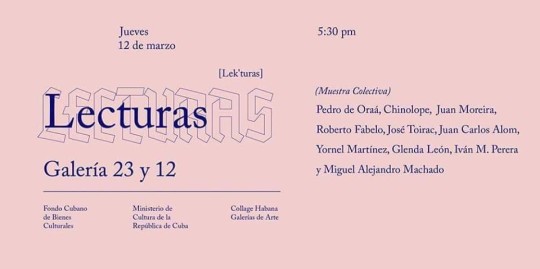
View On WordPress
#2020#Chinolope#Galería 23 y 12#Glenda León#Iván M. Perera#José Ángel Toirac#Juan Carlos Alom#Juan Moreira#Miguel Machado#Muestra Colectiva#Pedro de Oraá#Roberto Fabelo#Yornel Martínez
0 notes
Text
Exposición "10 de 500 La Cuadratura del Círculo", Colectiva
Exposición “10 de 500 La Cuadratura del Círculo”, Colectiva
Exposición 10 de 500 La Cuadratura del Círculo
Colectiva
07.02.2020
Factoría Habana
“En 10 años de intensa presencia en el panorama de las artes visuales cubanas, el Centro de Arte Contemporáneo Factoría Habana se ha dado la labor de funcionar como medidor y propulsor de la producción nacional. Sobrepasando la cifra de treinta exhibiciones, ha presentado la obra de los actores más activos y…

View On WordPress
#2020#Adonis Ferro#Alejandro Campins#Antonio Eligio Tonel#Carlos Martiel#Cirenaica Moreira#Duvier del Dago#Ernesto Niebla#Ernesto Oroza#Esterio Segura#Fabián Múñoz#Fernando Rodríguez#Galería Factoría Habana#Humberto Diaz#José Ángel Toirac#José M. Mesías#Luis Gomez#Muestra Colectiva#Octavio C. Marín#Rafael Villares#René Peña#Rocío García#Sandra Ramos
0 notes
Text
Exposición "Ars longa", José Ángel Toirac
Exposición “Ars longa”, José Ángel Toirac
Exposición “Ars longa”
José Ángel Toirac
20.12.2019
Museo Nacional de Bellas Artes Cuba
“Vita brevis, ars longa, occasio praeceps, experimentum periculosum, iudicium difficile.”
(La vida es breve, el arte largo, la ocasión fugaz, la experiencia confusa, el juicio difícil)
Hipócrates
“Por estos días el Museo Nacional de Bellas Artes acoge una muestra personal de José Ángel Toirac. La…
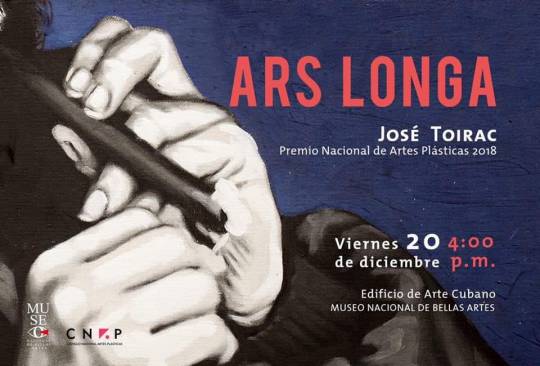
View On WordPress
1 note
·
View note
Text
Exposición "A imagen y semejanza", Colectiva
Exposición “A imagen y semejanza”, Colectiva
Exposición “A imagen y semejanza”
Colectiva
04.10.2019
Fábrica de Arte Cubano
Exposición colectiva de artistas visuales en Fábrica de arte… Un recorrido visual por las principales tendencias del arte contemporáneo cubano.
“Toda obra lleva en sí una cierta verdad del que la crea. Todo autorretrato es también una ficción. A imagen y semejanza, el artista y la obra se crean uno a otro. Y, sin…

View On WordPress
#2019#Adonis Ferro#Adonis Flores#Ailen Maleta#Alejandra Glez#Andy Calzadilla#Carlos Quintana#Cirenaica Moreira#Elio Jesús Fonseca#Fábrica de Arte Cubano#Fernando Rodríguez#Gabriel Guerra Bianchini#Gabriela Reyna#Gertrudis Rivalta Oliva#Irolán Maroselli#Jenny Brito#José Ángel Toirac#Katiuska Saavedra#Lázaro Saavedra#Lianet Martínez#Liudmila & Nelson#Mabel Poblet#Muestra Colectiva#Rafael Miranda San Juan#Reinier Nande#René Peña#Ronald Vill#VAE#Yanahara Mauri Villareal
0 notes
Text
Exposición “Esto no es un tributo”
José Ángel Toirac
06.09.2019
Galería Acacia
“Toda la gloria del mundo cabe en un grano de maíz” es la pieza eje de esta exposición -a criterio de este visitante- ella no dice desde ya en presencia de que estamos. @meirytoi Jose Angel Toirac Batista Premio Nacional de Artes Plásticas nos permite recorrer una arista especial de su creación artística, la imagen…

View On WordPress
0 notes